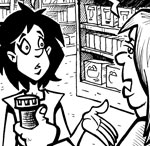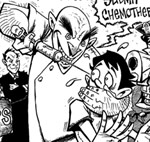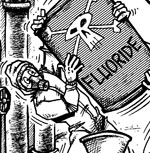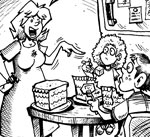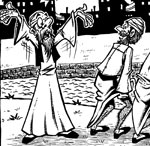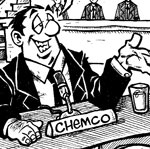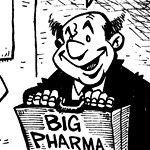The Ayurvedic Herb that Mainstream Science Is Only Beginning to Understand
| Share on Facebook | Share on Twitter | Share on Google+ |
Several years ago I was approached by a very hip ninety year-old woman who had developed an interest in herbs. "Tell me about that cholesterol medication developed by the Goo Goo Dolls," she asked, this proper name belonging to an American alternative rock group. After several minutes of puzzled conversation, we ascertained that she was interested in the cholesterol-lowering effects of the Ayurvedic herb known as guggul, not the pharmaceutical adventures of the musicians of the Goo Goo Dolls.
Guggul is the most commonly used name to describe preparations made from the gum or resin of Commiphora wightii, also known as Commiphora mukkul, or the myrrh tree. Boswellia is the frankincense tree, and Commiphora is the myrrh tree.
Actually, describing the guggul plant as a tree is something of an overstatement. In the desert climates where it is most often grown, it is more of a bush. Growing only about 1.5 meters (4-5 feet) high, the guggul plant produces a dark resin that is more intensely scented when the plant grows under severe drought conditions. The resin is collected to make an Ayurvedic herbal preparation known as guggulu, and it is also sold in packets for use as incense called dhoop, which is used to fulfill the dharma of detoxification.
Understanding the Different Ayurvedic Preparations of Guggul
If you were to Google guggul, you would also find listings for gokshuradi guggulu. This is an Ayurvedic herbal formula that combines guggul with gokshuradi, better known as the Tribulus terrestris familiar to users of muscle building supplements, with black pepper and a variety of fruits to support kidney function and male sexual health.
You probably would not find many pages (I don't get my information via Google, so I don't really know) for kaishor or kaishore guggulu. This Ayurvedic formula incorporates guggul and triphala, the herb that is better known for quelling digestive upset. It adds ginger and other anti-inflammatory fruits and herbs to treat allergies.
Lakshadi guggulu, also known as divya lakshadi guggulu, is a guggul-based formula designed to promote bone health. It was originally used to help repair broken bones, but it is now more often used to treat osteoporosis. Maha Yograj guggulu, also known as mahayograj guggulu, is designed for joint pain that is caused by overindulgence in protein foods, especially gout. People who are given this formula are often told to eat sour and bitter foods, such as green papaya and bitter gourd.
Kanchnar guggulu was originally used to treat goiter. Nowadays, it is used for a variety of endocrine disorders. And simple preparations of guggul resin are used to treat high cholesterol and joint pain.
Scientific clinical testing of guggul and Ayurvedic formulas made with guggul gets mixed results, for a very simple reason. Science defines health in terms of diseases, and Ayurveda defines health in terms of people. Different people can have the same disease as it is defined by some laboratory test, and very different diseases in terms of the energy states known as doshas used in Ayurvedic medicine.
This means that sometimes these formulas get very good results, and sometimes they don't. This article is about helping you find out whether a product based on guggul extract is likely to work for you.
Using Guggul to Lower Cholesterol
The most common application of guggul products outside of India is to lower cholesterol. Sometimes guggul extracts really, really work. Sometimes they really, really don't.
High cholesterol was not considered to be a disease condition until the late 1960's. When the cholesterol-atherosclerosis condition was first being publicized, a scientist in India began to scrutinize the ancient texts of Ayurveda to look for a treatment that would be affordable for Indian patients.
The connection was made between guggul, cholesterol, and inflammation, so Indian scientists tested guggul extracts in animals to make sure it was safe. Then a clinical trial involving the use of 1,500 mg of guggul extract a day, equivalent to 75 mg of guggulsterones a day, found that it lowered total cholesterol 22% and triglycerides 25%. Another clinical trial involving 233 people found that guggullipids lowered total cholesterol as well as the then-standard cholesterol medication clofibrate and also raised levels of the protective HDL cholesterol.
Based on the the explanation of the herb in Ayurvedic medicine, Indian scientists looked for evidence that somehow guggul normalizes thyroid function and thereby normalizes cholesterol levels. This mode of action has never been proven. It is also possible that the guggul mixes with bile in the intestine and makes it "stickier" for cholesterol. But this is not conclusively proven, either.
Indian physicians recommend guggul because it works. American scientists set out to protect the market for statin drugs.
When scientists at the University of Pennsylvania tested "low-dose" and "high-dose" standardized guggul extract against a placebo among 100 patients who had high cholesterol for a study they published in the venerable Journal of the American Medical Association, they found no benefit. A practitioner of Ayurvedic medicine might look at the results and say, "Well, of course." In fact, anyone taking a close look at the data would reach the same conclusion.
As is so often the case with experiments that fail to find benefits of herbal medicines, the patients in the University of Pennsylvania study were not, apparently, randomly assigned to treatment or placebo groups. The scientists gave the highest dose of guggulsterones to patients who were eating the least fat and the lowest total calories, 33% less dietary fat and 33% fewer calories, even though they were at the same weight. They gave the placebo to patients who were eating 50% more fat and 50% more calories, even though they were at the same weight. If you are going to test whether a product lowers cholesterol or not, you probably would want the test group and the placebo group to be following similar diets.
Moreover, the American scientists tested dosages of 10 mg and 20 mg of guggulsterones per day. The Indian studies tested dosages of 75 mg of guggulsterones per day. If you want to show that an herbal product doesn't work, it helps to give less than the established therapeutic dose. This is done in American medical studies over and over again. I think there is an intention to skew the results to discourage the use of anything other than prescription medications in some studies (although not in all).
More importantly, Ayurvedic medicine would not designate guggul as "one treatment fits all." The people who benefit from guggul are not "anybody who has high cholesterol." The people who benefit from guggul are those who need to "pacify the doshas," that is, who are eating too much and doing too much and too full of nervous energy.
There is also a group of people that Ayurvedic medicine says should not get guggul. These are people who have "pitta excess." These are people who have very active digestive systems that produce a lot of bile. Their digestive tracts are already flushing away cholesterol, but giving them something else to flush away cholesterol is not likely to do a lot of good, especially if they are following low-calorie diets. The people whom Ayurvedic medicine would say would benefit most from the treatment didn't get it in this test, and the people whom Ayurvedic medicine would say would benefit least did.
This principle probably explains why tests of guggulsterones for lowering cholesterol conducted in India reliably find that it works and tests of guggulsterones for lowering cholesterol conducted in the United States don't.
But should you take guggulsterones to lower cholesterol?
How to Take Guggul for High Cholesterol
First of all, the one thing the study in the Journal of the American Medical Association tells us for sure is that taking just 1/7 to 1/3 of the recommended dose of guggulsterones is not going to do you any good. You need to take 1,500 mg a day of a preparation standardized to yield 75 mg of guggulsterones.
Probably you would take a product that is labeled triphala guggulu, so labeled to help people who aren't familiar with Ayurvedic medicines to choose the formula that is made with triphala fruit. This formula is usually called kaishore guggulu in India.
Take the product every day. Discontinue if you experience stomach upset, most likely to be diarrhea. (If the product gives you diarrhea, that is a good sign you don't need it.) Don't take guggul if you are pregnant.
Then you need to be sure to get your cholesterol tested in about two months to see how well the treatment is working.
Not everyone should take guggul. If you are thin, active, and on a low-fat vegetarian diet, it won't help you nearly as much as if you are overweight, sedentary, and you like your French fries and burgers.
I always tell people that natural products should be held to the same standards of efficacy as prescription medications. Compare your cholesterol levels before you take guggul with your cholesterol levels afterward. If they go down, assume what you are doing worked. If they don't, try something else. If you doesn't work, you can get your money back for the herbal product-try doing that for a prescription.
What About Guggul for Joint Pain?
The thing to know about using guggul for treating joint pain is that different people need different formulas. Ayurvedic medicine prescribes different formulas for different doshas, or patterns of symptoms.
Kaishor guggulu is used to treat "pitta joint pain." It is a formula that combines guggul with ginger root (Zingiber officinale), guduchi stem (Tinospora cordifolia), amalaki fruit (Emblica officinalis), bibhitaki fruit (Terminalia belerica), haritaki fruit (Terminalia chebula), danti root (Baliospermum montanum), nishoth root (Operculina turpethum), and black pepper. It's really best to go to a health practitioner to determine whether you have a "pitta imbalance," but the people who benefit most from this formula have hot, sharp, stabbing joint pain. Ice packs make it feel better. Heat makes it feel worse. Leafy greens in the diet reduce pain, while coffee and alcohol make it worse.
Punarmavadi guggulu is used to treat "kapha joint pain." It is a formula that combines guggulu with punarnava root (Boerhaavia diffusa), ginger root (Zingiber officinale), eranda root (Ricinus communis), nishoth root (Operculina turpethum), guduchi stem (Tinospora cordifolia), danti root (Baliospermum montanum), amalaki fruit (Emblica officinalis), bibhitaki fruit (Terminalia belerica), baritaki fruit (Terminalia chebula), chitrak root (Plumbago zeylanica), bhallataka herb (Semecarpus anacardium), black pepper, and rock salt. This kind of pain is usually dull. The joints are swollen, and they feel better when heat is applied. The diet that supports recovery from this kind of pain eliminates wheat and dairy and most oils.
Simhanad guggulu is used to treat "ama joint pain." It is a formula that combines guggul with castor oil, amalaki fruit (Emblica officinalis), bibhitaki fruit (Terminalia belerica), and haritaki fruit (Terminalia chebula). This formula is for "toxic" joint pain. Treatment for this condition usually includes a very light diet with lots of soups and broths. Of all the formulas for joint pain, this is the one most likely to cause diarrhea. That's not an intended effect, so discontinue the formula if diarrhea occurs.
There are other guggulu formulas for specific symptoms. While you are free to experiment with these formulas if you like, and there are no known interactions with medication, it is also best to take Ayurvedic medicines under the direction of an Ayurvedic practitioner who has the opportunity to examine you and speak with you to confirm you are getting the right formula for needed relief.
Selected References:
Agarwal RC, Singh SP, Saran RK, et al. Clinical trial of gugulipid-a new hypolipidemic agent of plant origin in primary hyperlipidemia. Indian J Med Res. 1986; 84: 626-634.
Arora RB, Taneja V, Sharma RC, Gupta SK. Anti-inflammatory studies on a crystalline steroid isolated fromCommiphora mukul. Indian J Med Res. 1972; 60: 929-931.
Chawla A, Saez E, Evans RM. "Don't know much bile-ology. "Cell. 2000; 103: 1-4.
Cui J, Huang L, Zhao A, et al. Guggulsterone is a farnesoid X receptor antagonist in coactivator association assays but acts to enhance transcription of bile salt export pump. J Biol Chem. 2003; 278: 10214-10220.
Das Gupta R. A new hypolipidaemic agent (gugulipid). J Assoc Physicians India. 1990; 38: 186.
Das Gupta R. Gugulipid: pro-lipaemic effect. J Assoc Physicians India. 1990; 38: 598.
De Smet PA. Herbal remedies. N Engl J Med. 2002; 347: 2046-2056.
Dev S. Ethnotherapeutics and modern drug development: the potential of Ayurveda. Curr Sci. 1997; 73: 909-928.
Duwiejua M, Zeitlin IJ, Waterman PG, Chapman J, Mhango GJ, Provan GJ. Anti-inflammatory activity of resins from some species of the plant family Burseraceae. Planta Med. 1993; 59: 12-16.
GhoraiM, Mandal SC, Pal M, Pal SP, Saha BP. A comparative study on hypocholesterolaemic effect of allicin, whole germinated seeds of bengal gram and guggulipid of gum gugglu. Phytother Res. 2000; 14: 200-202.
Goldman P. Herbal medicines today and the roots of modern pharmacology. Ann Intern Med. 2001; 135(8 pt 1): 594-600.
Gopal K, Saran RK, Nityanand S, et al. Clinical trial of ethyl acetate extract of gum gugulu (gugulipid) in primary hyperlipidemia. J Assoc Physicians India. 1986; 34: 249-251.
Kuppurajan K, Rajagopalan SS, Rao TK, Sitaraman R. Effect of guggulu (Commiphora mukul-Engl. ) on serum lipids in obese, hypercholesterolemic and hyperlipemic cases. J Assoc Physicians India. 1978; 26: 367-373.
Malhotra SC, Ahuja MM, Sundaram KR. Long-term clinical studies on the hypolipidaemic effect ofCommiphora mukul(Guggulu) and clofibrate. Indian J Med Res. 1977; 65: 390-395.
Malhotra SC, Ahuja MM. Comparative hypolipidaemic effectiveness of gum guggulu (Commiphora mukul) fraction 'A', ethyl-P-chlorophenoxyisobutyrate and Ciba-13437-Su. Indian J Med Res. 1971; 59: 1621-1632.
Nagarajan M, Waszkuc TW, Sun J. Simultaneous determination of E- and Z-guggulsterones in dietary supplements containingCommiphora mukulextract (guggulipid) by liquid chromatography. J AOAC Int. 2001; 84: 24-28.
Nityanand S, Kapoor NK. Cholesterol lowering activity of the various fractions of guggul. Indian J Exp Biol. 1973; 11: 395-398.
Nityanand S, Srivastava JS, Asthana OP. Clinical trials with gugulipid: a new hypolipidaemic agent. J Assoc Physicians India. 1989; 37: 323-328.
Panda S, Kar A. Gugulu (Commiphora mukul) induces triiodothyronine production: possible involvement of lipid peroxidation. Life Sci. 1999; 65: PL137-PL141.
Russell DW. Nuclear orphan receptors control cholesterol catabolism. Cell. 1999; 97: 539-542.
Satyavati GV. Gum guggul (Commiphora mukul)-the success story of an ancient insight leading to a modern discovery. Indian J Med Res. 1988; 87: 327-335.
Sinal CJ, Tohkin M, Miyata M, Ward JM, Lambert G, Gonzalez FJ. Targeted disruption of the nuclear receptor FXR/BAR impairs bile acid and lipid homeostasis. Cell. 2000; 102: 731-744.
Singh RB, Niaz MA, Ghosh S. Hypolipidemic and antioxidant effects ofCommiphora mukulas an adjunct to dietary therapy in patients with hypercholesterolemia. Cardiovasc Drugs Ther. 1994; 8: 659-664.
Szapary PO, Wolfe ML, Bloedon LT, Cucchiara AJ, DerMarderosian AH, Cirigliano MD, Rader DJ. Guggulipid for the treatment of hypercholesterolemia: a randomized controlled trial. JAMA. 2003 Aug 13; 290(6): 765-72.
Tripathi YB, Malhotra OP, Tripathi SN. Thyroid stimulating action of Z-guggulsterone obtained fromCommiphora mukul. Planta Med. 1984; 1: 78-80.
Urizar NL, Liverman AB, Dodds DT, et al. A natural product that lowers cholesterol as an antagonist ligand for the FXR. Science. 2002; 296: 1703-1706.
Verma SK, Bordia A. Effect ofCommiphora mukul(gum guggulu) in patients of hyperlipidemia with special reference to HDL-cholesterol. Indian J Med Res. 1988; 87: 356-360.
Wu J, Xia C, Meier J, Li S, Hu X, Lala DS. The hypolipidemic natural product guggulsterone acts as an antagonist of the bile acid receptor. Mol Endocrinol. 2002; 16: 1590-1597.
-
Skin CareMen Skin Care
-
Free ResourcesFree eBooks
-
Half the costs of illness are wasted on conditions that could be prevented.Dr. Joseph Pizzorno
-
What We RecommendIf you do an analysis of the ingredients in a bottle of
 Total Balance and compare with other products you will find that it provides exceptional value for money…even against simple mass produced products with lower bottle costs.
Total Balance and compare with other products you will find that it provides exceptional value for money…even against simple mass produced products with lower bottle costs.
-





